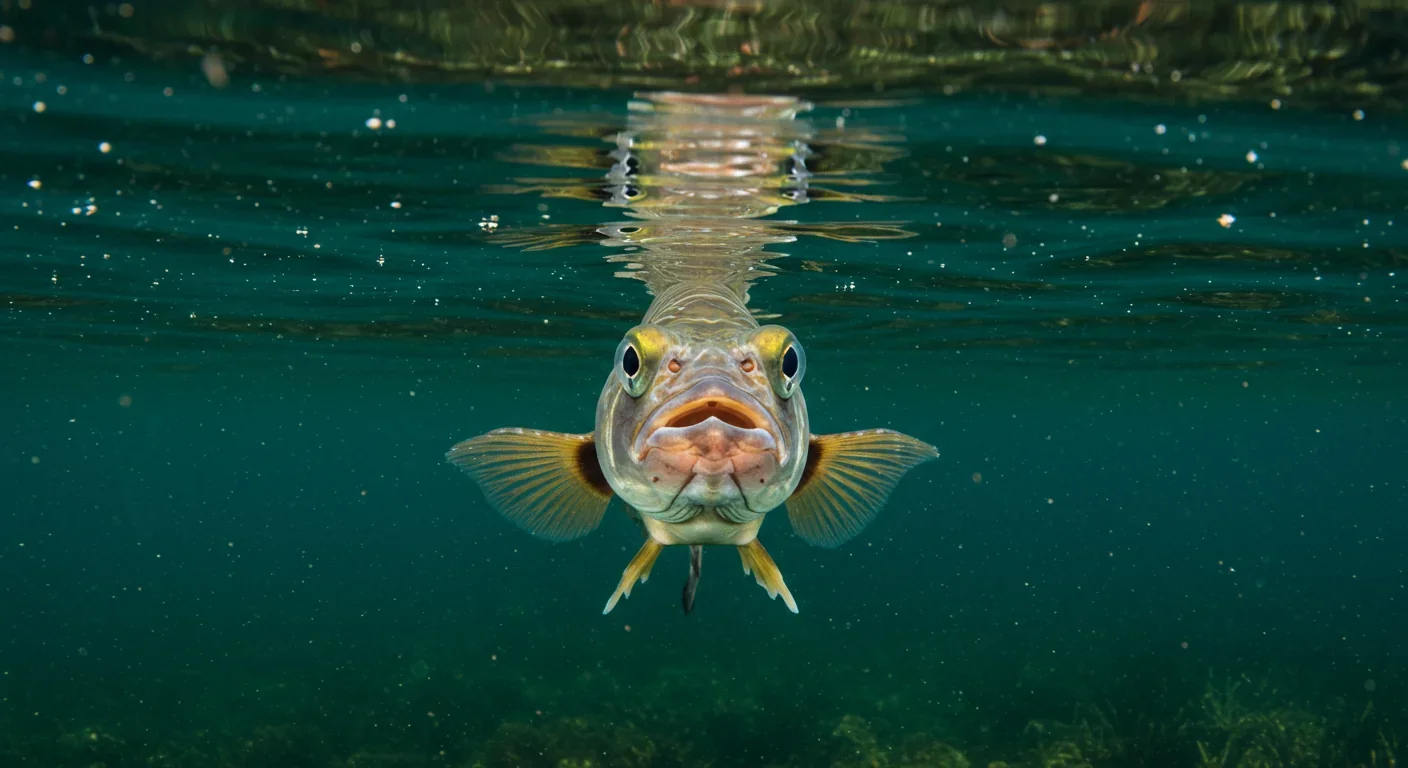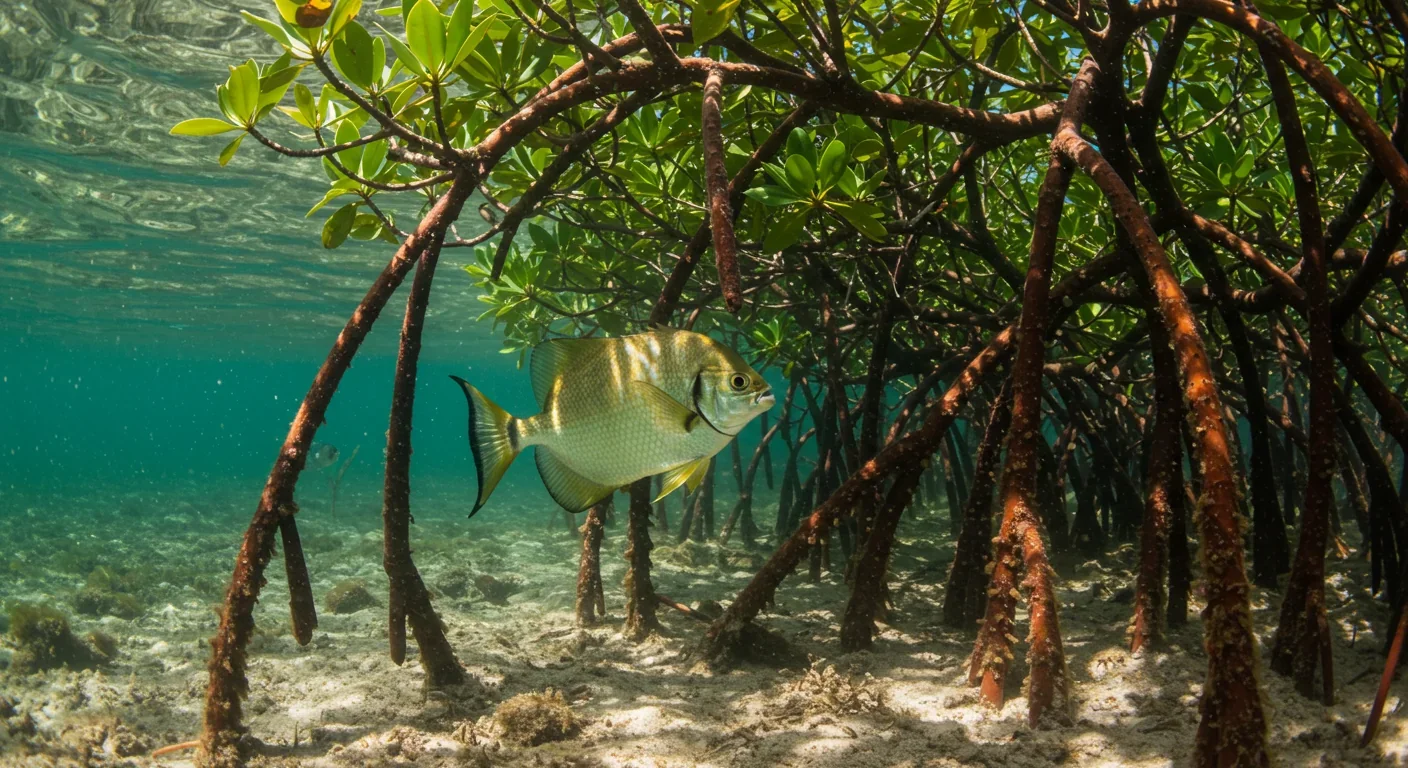Forest Biological Clocks: Ecosystems That Keep Time

TL;DR: Archerfish solve complex physics problems instantly, compensating for refraction, gravity, and target distance to shoot water jets with 80%+ accuracy—all without conscious calculation. Their biological ballistics computer is now inspiring revolutionary biomimetic technologies from precision agriculture to medical devices.
Adult archerfish almost never miss. When a spider perches on a mangrove branch three meters above the water's surface, the fish positions itself below, forms its mouth into a precision nozzle, and fires a jet of water that knocks the prey into the water with startling accuracy. The target falls, the fish claims its meal, and researchers scratch their heads trying to figure out how a brain the size of a pea just calculated what would take humans a whiteboard full of equations.

What scientists discovered changed how we think about intelligence itself. The archerfish doesn't just aim and shoot—it actively compensates for the refraction of light at the water-air interface, adjusts jet power based on target distance, and even predicts where moving prey will be by the time its projectile arrives. This isn't instinct. It's computation.
High-speed photography revealed the mechanism behind their impossible accuracy. The archerfish doesn't fire a continuous stream. Instead, it launches what engineers now call a "hammer jet"—a carefully timed pulse where the trailing water travels faster than the leading edge, causing the entire stream to converge into a high-impact blob milliseconds before striking the target. The fish adjusts this timing based on distance, creating maximum impact force exactly when needed.
The archerfish's "hammer jet" delivers 7.5 times more impact force than a continuous water stream—a principle now revolutionizing industrial cleaning systems and inspiring next-generation precision technologies.
Long before humans developed projectile weapons, archerfish ancestors faced a unique evolutionary pressure. Their brackish mangrove habitats teemed with insects on overhanging vegetation—abundant food sources just out of reach. Most fish would go hungry. But random mutations gave some individuals specialized anatomy: a groove in the roof of the mouth, a tongue that could form a narrow channel, and forward-facing eyes that enabled binocular vision.
These early water-spitters had terrible aim. But the ones who survived long enough to reproduce passed on slight improvements—sharper vision, better muscle control, more efficient mouth structures. Over millions of years, natural selection refined the system. The banded archerfish can now target prey up to three meters above the surface, hitting moving targets more than 50% of the time after training.
Previous evolutionary adaptations prepared us for this discovery. Electric fish evolved biological radar. Echolocating bats developed biological sonar. Archerfish developed biological ballistics calculators. Each represents nature solving engineering problems through iteration rather than design—and often arriving at solutions that outperform our best technology.

The fossil record doesn't preserve soft tissue well, so we can't trace the exact evolutionary path. But comparative anatomy shows that archerfish share a common ancestor with other perciform fishes around 50 million years ago. Somewhere along that timeline, one lineage stumbled onto water-jetting as a feeding strategy and never looked back.
Here's where it gets wild. When you throw a ball, you unconsciously calculate trajectory, compensate for wind, account for the target's movement. You learned this through years of trial and error, building neural pathways that translate visual input into motor output. Archerfish do the same thing—but they're solving a harder problem.
The fish forms its mouth and tongue into a tube, creating what's essentially a biological squirt gun using a structure called the basihyal. When its gill covers (opercula) snap shut, they pressurize the water chamber and force a jet through the mouth tube at velocities approaching 2-4 meters per second. But the genius lies in the timing.
The archerfish varies the duration and pressure of its gill squeeze, making the back of the water jet travel faster than the front. As the jet flies through the air, this speed differential causes it to compress into a single, high-impact blob that arrives at the target with seven and a half times more force than a continuous stream would deliver.
"Archerfish have remarkable hunting skills, firing jets of water at insects on plants above the water surface with incredible aim that can hit targets up to 3 meters away."
— Exploration Junkie Research Team
Think about what this requires. The fish must calculate target distance, adjust for the parabolic arc of the projectile, account for air resistance, and time the pressure pulse so the blob forms exactly at impact—not too early, not too late. It does this in a fraction of a second, underwater, looking up through a refractive interface that makes everything appear displaced from its actual position.
And that's just the physics. The fish also needs to recognize which objects are edible (spiders yes, leaves no), determine if they're within range, position itself for the optimal shot angle, and decide whether to shoot at all. When other archerfish are nearby, individuals will aim more carefully and shoot from closer distances, reducing the risk that a competitor will steal their prey.
Light bends when it passes between water and air. This makes objects above the surface appear displaced from their actual position—a phenomenon called refraction that frustrates spearfishers and confuses children at aquariums. If you aim directly at where a fish appears to be, you'll miss. You need to aim where it actually is.

Archerfish face this challenge in reverse. Their prey appears shifted from its true location, yet they compensate for refraction with remarkable consistency. How? Researchers initially thought the fish might learn a simple rule: aim X degrees below the apparent target. But experiments revealed something far more sophisticated.
The fish carefully position their eyes when shooting, keeping targets within a specific visual zone that minimizes refraction errors. They also show a preference for positioning themselves directly beneath the prey when possible, which reduces the viewing angle and thus the magnitude of refraction. This suggests they're not just passively compensating—they're actively manipulating their position to simplify the physics problem.
Recent studies of the archerfish visual system uncovered something unexpected: neurons in the optic tectum encode object category information remarkably early in visual processing. Unlike primates, where object recognition emerges later in the visual pathway, archerfish brains represent "edible insect" versus "inedible leaf" at almost the first stage of processing. This rapid categorization may be part of the integrated sensorimotor system that enables such precise targeting.
Archerfish brains process object categorization at the earliest stages of vision—a specialized adaptation that enables split-second targeting decisions without the cortical processing humans require for similar tasks.
But here's the puzzle that keeps neuroscientists up at night: the fish don't have a cortex. The neural structures that allow humans to perform conscious calculation simply don't exist in fish brains. So where does the computation happen? The answer seems to be distributed processing—networks of neurons that encode the relationship between visual angle, motor output, and successful hits through trial and error, building an internal model of projectile physics without ever understanding physics.
When archerfish are about one inch long, they start practicing. Their early attempts are embarrassingly bad—jets that fall short, overshoot, or miss entirely. But they keep trying, and more importantly, they keep watching.
A groundbreaking 2006 study revealed that archerfish benefit from observational learning. Young fish improve their accuracy by watching successful adults, absorbing the technique without needing to practice as much themselves. When a school member nails a shot, the others watch closely and adjust their techniques to match. This is social learning—a trait we once thought was limited to mammals and birds.

The learning process takes months to years. Juvenile archerfish gradually improve, perfecting their aim and hunting strategy by the time they reach maturity at one to two years old. This developmental timeline mirrors how human children learn to throw accurately—through observation, practice, feedback, and gradual refinement of neural circuitry.
But what exactly are they learning? Not physics equations—archerfish can't do algebra. Instead, their brains are building associative maps: this angle + this power = hit target at this distance. Every successful shot strengthens those neural connections. Every miss provides error correction. Over hundreds of attempts, the brain converges on a predictive model that works consistently, even though the fish has no conscious understanding of why.
This has profound implications for how we think about intelligence and computation. The archerfish demonstrates that you don't need symbolic reasoning or mathematical abstraction to solve complex physics problems. You need sensory input, motor output, a learning mechanism, and time. Evolution can build precision systems through iteration, creating biological calculators that outperform many designed systems.
The social dimension adds another layer. Individual learning is slow and error-prone. But when knowledge transfers between individuals—when experienced hunters can accelerate novice development—the entire population becomes more effective. This is culture in its simplest form: behaviors that improve survival, transmitted through observation rather than genetics.
Engineers at Germany's Fraunhofer Institute saw the archerfish and recognized a solution to a persistent industrial problem. Spray cleaning systems waste enormous amounts of water and energy because continuous jets disperse their force over time. The archerfish's hammer jet—where the stream concentrates into a high-impact blob—delivered exactly the focused power they needed.
The result was BionicJet, a spray cleaning system based on archerfish principles that delivers 7.5 times higher impact force than conventional jets while reducing cleaning time and fluid usage by 50-80%. This isn't just incremental improvement. It's a paradigm shift in how we think about directed fluid flow.
"The hammer jet effect—where a fluid jet becomes a high-impulse blob due to volume concentration—can reduce cleaning time and fluid usage by up to 80%."
— Fraunhofer Institute for Process Engineering and Packaging
The applications extend far beyond cleaning. Precision agriculture could use archerfish-inspired water jets to deliver nutrients to specific plants without waste. Targeted drug delivery systems might employ similar principles to concentrate therapeutic compounds exactly where needed. Fire suppression equipment could benefit from the increased impact force. Medical procedures requiring precise fluid delivery—arthroscopic surgery, dental work, wound irrigation—all could improve with better understanding of how archerfish optimize their jets.

This represents biomimicry at its finest: not just copying nature's forms, but understanding the underlying principles and translating them across contexts. The archerfish doesn't care about industrial cleaning or medical procedures. It just wants to eat spiders. But the physics it employs—volume concentration through velocity differentials—works whether you're a fish hunting insects or an engineer solving real-world problems.
What's particularly striking is that nature arrived at this solution through random mutation and selection pressure, while human engineers required sophisticated fluid dynamics modeling and years of research. The archerfish's ancestors didn't understand Bernoulli's principle or momentum transfer. They just survived and reproduced slightly more successfully than their neighbors, and over millions of generations, that was enough to produce engineering excellence.
While European engineers biomimicked the archerfish's hammer jet, Japanese roboticists took a different approach. They wanted to replicate the entire sensorimotor system—the vision, targeting, and execution in an integrated package. The challenge revealed how much we still don't understand about biological computation.
Building a robot that can shoot water isn't hard. Building one that can compensate for refraction, adjust for distance, predict moving targets, and learn from mistakes? That's exponentially more difficult. The archerfish accomplishes all this with roughly 10 million neurons. Our best AI targeting systems require billions of parameters, massive training datasets, and computational power that would drain the fish's energy budget in seconds.
This computational efficiency gap has researchers worldwide rethinking artificial intelligence architectures. Chinese neuroscientists are mapping the archerfish optic tectum, hoping to understand how early categorical processing enables such rapid decision-making. Australian behavioral ecologists are studying how schooling dynamics influence individual learning rates, looking for principles that might improve collaborative AI systems.
In India, researchers are exploring whether archerfish-inspired targeting could help smallholder farmers with precision water delivery in regions where every drop counts. In California, startups are developing camera systems that use archerfish visual processing principles to track and categorize objects in real-time with minimal computational overhead.
Each research group brings different priorities and perspectives, shaped by their environmental challenges and technological contexts. But they're all converging on a common realization: biological systems achieve remarkable performance with minimal resources by exploiting clever algorithms, specialized hardware, and learning mechanisms refined over evolutionary time.
The archerfish achieves precision targeting with just 10 million neurons and minimal energy consumption—revealing how nature solves complex problems with extraordinary efficiency that our most advanced AI systems can't match.
The cross-cultural interest in archerfish research also reflects growing recognition that nature has already solved many problems we're currently struggling with. Climate change intensifies water scarcity, making water-efficient technologies critical. Robotics demands better targeting without massive computational overhead. Medical procedures require ever-greater precision with minimal tissue damage. In each case, looking to biology for inspiration proves more fruitful than purely engineering-focused approaches.
For decades, we measured intelligence by the yardstick of human cognition. Abstract reasoning, symbolic language, tool use, self-awareness—these became the benchmarks. Animals that lacked these traits were dismissed as operating on instinct, biological automata executing genetic programming without true understanding.
The archerfish demolishes this framework. It doesn't have abstract reasoning or symbolic language, yet it solves physics problems most humans couldn't calculate without tools. It demonstrates that intelligence isn't a single dimension but a multidimensional landscape where different organisms excel at different challenges based on evolutionary pressures.
This realization is transforming artificial intelligence research. For years, AI focused on replicating human-style cognition: chess-playing algorithms, language models, reasoning systems. These approaches achieved remarkable success but required enormous computational resources and struggled with tasks that animals handle effortlessly.
Now researchers are exploring alternative architectures inspired by animal cognition. Embodied AI emphasizes tight coupling between sensors, processors, and actuators—like the archerfish's integrated visual-motor system. Reservoir computing uses the inherent dynamics of physical systems to perform computations, similar to how the fish's neural networks may exploit brain structure itself as part of the calculation. Neuromorphic chips mimic biological neural organization, achieving better efficiency by copying evolutionary solutions rather than designing from scratch.
The implications extend beyond technology. Understanding how archerfish learn and compute challenges our assumptions about consciousness and awareness. Does the fish "know" it's compensating for refraction, or does it simply possess neural circuitry that implements refraction compensation without awareness? Does it "understand" projectile motion, or does understanding require symbolic representation?
These aren't just philosophical questions. They shape how we approach animal welfare, conservation policy, and our relationship with the natural world. If a fish can solve complex problems without conscious awareness, what does that say about cognition in other species? How many animals possess sophisticated computational abilities we've overlooked because they don't match our preconceptions about intelligence?
The archerfish suggests that intelligence emerges from the interaction between bodies, brains, and environments—not from disembodied reasoning. Its precision targeting arises from eyes positioned for binocular vision, mouth structures that create focused jets, neural circuits that learn through feedback, and millions of years of selection pressure favoring accuracy. Remove any component and the system fails.
This holistic view contrasts sharply with traditional AI, which treats intelligence as software running on hardware. The archerfish shows that in biological systems, there's no clear separation. The physics of water jets, the optics of refraction, the biomechanics of gill plates—all contribute to the computational outcome. Intelligence isn't located in the brain alone but distributed across the entire organism and its interaction with the world.
Within the next decade, archerfish-inspired technologies will likely become commonplace in ways most people won't notice. Precision irrigation systems, industrial cleaning equipment, medical devices, robotics—all quietly employing principles discovered by watching fish shoot bugs.
This trend represents a broader shift toward biomimicry as a primary engineering strategy. For centuries, humans designed technologies from first principles, using mathematics and physics to create solutions from scratch. But nature has 3.8 billion years of research and development, having tested trillions of designs across every environment on Earth. Why not learn from those experiments?
The challenge is translation. Natural systems evolved for specific ecological contexts, not human applications. The archerfish optimized for catching insects in mangrove estuaries, not cleaning industrial equipment. Extracting transferable principles requires deep understanding of both the biological system and the engineering problem.
This creates new opportunities and demands for interdisciplinary skills. The biomimetic engineer of 2030 needs expertise spanning biology, physics, materials science, and traditional engineering. They need to observe animal behavior, decode neural mechanisms, model fluid dynamics, and design manufacturing processes. Educational institutions are slowly adapting to this reality, creating programs that bridge life sciences and engineering.
For individuals preparing for this future, curiosity about nature becomes a professional asset. The next breakthrough might come from observing how geckos climb walls, how whales communicate across oceans, or how bacteria navigate chemical gradients. Each biological system potentially holds solutions to human challenges, if we learn to recognize and translate them.
The archerfish also reminds us to look beyond charismatic megafauna. Popular science focuses on dolphins, primates, and elephants—animals whose intelligence resembles ours. But remarkable problem-solving appears across the tree of life, in insects, fish, even plants. Expanding our attention reveals a much richer landscape of biological innovation.
As climate change and resource constraints intensify, biomimetic approaches that minimize energy and material use while maximizing efficiency become increasingly valuable. Nature excels at doing more with less—the archerfish achieves incredible precision with a brain that weighs a fraction of a gram and runs on the energy equivalent of a few insects per day. Our technologies need to move in that direction, and biology provides the blueprints.
The future isn't about choosing between nature and technology. It's about recognizing that nature is technology—evolved, tested, optimized technology that we're only beginning to understand and harness. The archerfish, solving physics problems its ancestors couldn't have imagined, swimming in mangroves it doesn't know are threatened, points toward a way forward where human innovation learns from, rather than dominates, the living world.
The fish aims, shoots, and almost never misses. Three meters away, a spider falls into the water. The archerfish swims forward to claim its prize, unaware that halfway around the world, engineers are trying to replicate what it does effortlessly. Nature's precision engineer doesn't need recognition or understanding. It just needs to eat. But we need it—not just for the biomimetic technologies it might inspire, but for what it teaches us about intelligence, computation, and the astonishing capabilities hidden in unexpected places.
If a fish can solve physics, what else are we missing?

MOND proposes gravity changes at low accelerations, explaining galaxy rotation without dark matter. While it predicts thousands of galaxies correctly, it struggles with clusters and cosmology, keeping the dark matter debate alive.

Ultrafine pollution particles smaller than 100 nanometers can bypass the blood-brain barrier through the olfactory nerve and bloodstream, depositing in brain tissue where they trigger neuroinflammation linked to dementia and neurological disorders, yet remain completely unregulated by current air quality standards.

CAES stores excess renewable energy by compressing air in underground caverns, then releases it through turbines during peak demand. New advanced adiabatic systems achieve 70%+ efficiency, making this decades-old technology suddenly competitive for long-duration grid storage.

Our brains are hardwired to see patterns in randomness, causing the gambler's fallacy—the mistaken belief that past random events influence future probabilities. This cognitive bias costs people millions in casinos, investments, and daily decisions.

Forests operate as synchronized living systems with molecular clocks that coordinate metabolism from individual cells to entire ecosystems, creating rhythmic patterns that affect global carbon cycles and climate feedback loops.

Generation Z is the first cohort to come of age amid a polycrisis - interconnected global failures spanning climate, economy, democracy, and health. This cascading reality is fundamentally reshaping how young people think, plan their lives, and organize for change.

Zero-trust security eliminates implicit network trust by requiring continuous verification of every access request. Organizations are rapidly adopting this architecture to address cloud computing, remote work, and sophisticated threats that rendered perimeter defenses obsolete.